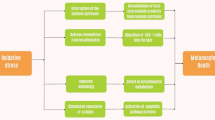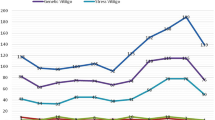Abstract
Catecholamines (epinephrine, norepinephrine and dopamine) are considered toxic to the melanocytes and may play an important role in the development of depigmented patches on the skin. This study was done to evaluate the levels of catecholamines in skin and plasma samples of active vitiligo patients’ and gene expression changes in catecholamines’ metabolism regulatory genes (COMT and GTPCH1), immunoregulatory genes (CTLA4 and PTPN22), and Catalase in active vitiligo patients. In this single-centre, prospective, case–control study, 30 patients with active vitiligo were recruited and skin biopsies from the perilesional site and plasma samples were collected. Skin biopsies from the normal site in vitiligo patients and healthy controls (n = 15) and plasma samples from controls were also obtained. Catecholamines’ estimation was done via high-performance liquid chromatography. Gene expression variations were investigated via reverse transcription–polymerase chain reaction (PCR) and real-time PCR. Epinephrine, norepinephrine and dopamine levels were significantly higher in perilesional skin biopsies as compared to controls (P = 0.035, 0.024, and 0.006, respectively). However, epinephrine, norepinephrine and dopamine levels observed in patients’ plasma samples were comparable to controls. The mRNA expression level of the Catalase gene was found to be upregulated at the perilesional site of patients as compared to the non-affected site of same patients (P < 0.001) and healthy controls (P = 0.037). Transcriptional expression of GTPCH1 and COMT were observed to be increased significantly at the perilesional site of patients in comparison to controls (P = 0.004 and P = 0.046, respectively). Our results support the presence of oxidative stress, inflammation and induced immune response in vitiligo patients at the perilesional sites. The increased inflammatory response may lead to catecholamines upregulation resulting in oxidative stress and melanocyte damage.





Similar content being viewed by others
Availability of data and materials
The data sets generated and analysed during the current study are available from the corresponding author on reasonable request.
References
Rashighi M, Harris JE (2017) Vitiligo pathogenesis and emerging treatments. Dermatol Clin 35(2):257–265. https://doi.org/10.1016/j.det.2016.11.014
Fan J, Zhang B, Shu HF, Zhang XY, Wang X, Kuang F et al (2009) Interleukin-6 increases intracellular Ca2+ concentration and induces catecholamine secretion in rat carotid body glomus cells. J Neurosci Res 87(12):2757–2762. https://doi.org/10.1002/jnr.22107
Schallreuter KU, Wood JM, Pittelkow MR, Gutlich M, Lemke KR, Rodl W et al (1994) Regulation of melanin biosynthesis in the human epidermis by tetrahydrobiopterin. Science 263(5152):1444–1446
Tchivileva IE, Nackley AG, Qian L, Wentworth S, Conrad M, Diatchenko LB (2009) Characterization of NF-kB-mediated inhibition of catechol-O-methyltransferase. Mol Pain 5:13. https://doi.org/10.1186/1744-8069-5-13
Katusic ZS, Stelter A, Milstien S (1998) Cytokines stimulate GTP cyclohydrolase I gene expression in cultured human umbilical vein endothelial cells. Arterioscler Thromb Vasc Biol 18(1):27–32. https://doi.org/10.1161/01.atv.18.1.27
Li K, Li C, Gao L, Yang L, Li M, Liu L et al (2009) A functional single-nucleotide polymorphism in the catechol-O-methyltransferase gene alter vitiligo risk in a Chinese population. Arch Dermatol Res 301(9):681–687. https://doi.org/10.1007/s00403-008-0920-8
Thöny B, Auerbach G, Blau N (2000) Tetrahydrobiopterin biosynthesis, regeneration and functions. Biochem J 347(Pt 1):1–16
Walunas TL, Lenschow DJ, Bakker CY, Linsley PS, Freeman GJ, Green JM et al (1994) CTLA-4 can function as a negative regulator of T cell activation. Immunity 1(5):405–413. https://doi.org/10.1016/1074-7613(94)90071-x
Steiner K, Moosig F, Csernok E, Selleng K, Gross WL, Fleischer B et al (2001) Increased expression of CTLA-4 (CD152) by T and B lymphocytes in Wegener’s granulomatosis. Clin Exp Immunol 126(1):143–150. https://doi.org/10.1046/j.1365-2249.2001.01575.x
Rieck M, Arechiga A, Onengut-Gumuscu S, Greenbaum C, Concannon P, Buckner JH (2007) Genetic variation in PTPN22 corresponds to altered function of T and B lymphocytes. J Immunol 179(7):4704–4710. https://doi.org/10.4049/jimmunol.179.7.4704
Gauthier Y, Cario Andre M, Taïeb A (2003) A critical appraisal of vitiligo etiologic theories. Is melanocyte loss a melanocytorrhagy? Pigment Cell Res 16(4):322–332. https://doi.org/10.1034/j.1600-0749.2003.00070.x
Liu L, Li C, Gao J, Li K, Zhang R, Wang G et al (2010) Promoter variant in the catalase gene is associated with vitiligo in Chinese people. J Investig Dermatol 130(11):2647–2653. https://doi.org/10.1038/jid.2010.192
Singh S, Singh U, Pandey SS (2012) Serum concentration of IL-6, IL-2, TNF-α, and IFNγ in Vitiligo patients. Indian J Dermatol 57(1):12–14. https://doi.org/10.4103/0019-5154.92668
Sushama S, Dixit N, Gautam RK, Arora P, Khurana A, Anubhuti A (2019) Cytokine profile (IL-2, IL-6, IL-17, IL-22, and TNF-α) in vitiligo-New insight into pathogenesis of disease. J Cosmet Dermatol 18(1):337–341. https://doi.org/10.1111/jocd.12517
Maine CJ, Hamilton-Williams EE, Cheung J, Stanford SM, Bottini N, Wicker LS et al (2012) PTPN22 alters the development of regulatory T cells in the thymus. J Immunol 188(11):5267–5275. https://doi.org/10.4049/jimmunol.1200150
Christensen AD, Skov S, Kvist PH, Haase C (2015) Depletion of regulatory T cells in a hapten-induced inflammation model results in prolonged and increased inflammation driven by T cells. Clin Exp Immunol 179(3):485–499. https://doi.org/10.1111/cei.12466
Klarquist J, Denman CJ, Hernandez C, Wainwright DA, Strickland FM, Overbeck A et al (2010) Reduced skin homing by functional Treg in vitiligo. Pigment Cell Melanoma Res 23(2):276–286. https://doi.org/10.1111/j.1755-148X.2010.00688.x
Lin M, Zhang BX, Shen N, Dong XJ, Zhang C, Qi XY et al (2014) Regulatory T cells from active non-segmental vitiligo exhibit lower suppressive ability on CD8+CLA+ T cells. Eur J Dermatol 24(6):676–682. https://doi.org/10.1684/ejd.2014.2436
Chatterjee S, Eby JM, Al-Khami AA, Soloshchenko M, Kang HK, Kaur N et al (2014) A quantitative increase in regulatory T cells controls development of vitiligo. J Investig Dermatol 134(5):1285–1294. https://doi.org/10.1038/jid.2013.540
Namazi MR (2007) Neurogenic dysregulation, oxidative stress, autoimmunity, and melanocytorrhagy in vitiligo: can they be interconnected? Pigment Cell Res 20(5):360–363. https://doi.org/10.1111/j.1600-0749.2007.00408.x
Schulz E, Jansen T, Wenzel P, Daiber A, Münzel T (2008) Nitric oxide, tetrahydrobiopterin, oxidative stress, and endothelial dysfunction in hypertension. Antioxid Redox Signal 10(6):1115–1126. https://doi.org/10.1089/ars.2007.1989
Nakamura K, Bindokas VP, Kowlessur D, Elas M, Milstien S, Marks JD et al (2001) Tetrahydrobiopterin scavenges superoxide in dopaminergic neurons. J Biol Chem 276(37):34402–34407. https://doi.org/10.1074/jbc.M103766200
Funding
None.
Author information
Authors and Affiliations
Contributions
Study concept and design: ST, AB, DP. Analysis and interpretation of data: ST, VT, AB. Drafting of the manuscript: ST, VT. Critical revision of the manuscript for important intellectual content: ST, VT, AB, DP. Statistical analysis: ST, VT. Study supervision: AB, DP.
Corresponding author
Ethics declarations
Conflict of interest
None declared.
Institutional ethical committee approval
This study was performed in line with the principles of the Declaration of Helsinki. Approval was granted by the Institutional Ethics Committee.
Consent to participate
Informed consent was obtained from all individual participants included in the study.
Additional information
Publisher's Note
Springer Nature remains neutral with regard to jurisdictional claims in published maps and institutional affiliations.
Rights and permissions
About this article
Cite this article
Tanwar, S., Thakur, V., Bhatia, A. et al. Catecholamines’ accumulation and their disturbed metabolism at perilesional site: a possible cause of vitiligo progression. Arch Dermatol Res 315, 173–180 (2023). https://doi.org/10.1007/s00403-022-02333-3
Received:
Revised:
Accepted:
Published:
Issue Date:
DOI: https://doi.org/10.1007/s00403-022-02333-3




